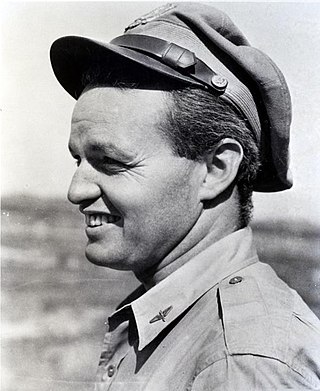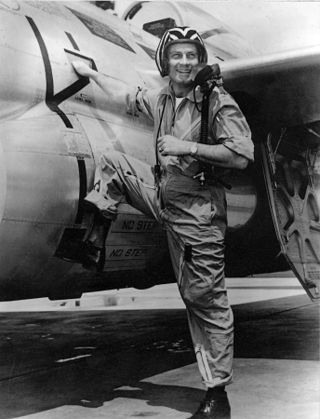Related Research Articles

The Desert Air Force (DAF), also known chronologically as Air Headquarters Western Desert, Air Headquarters Libya, the Western Desert Air Force, and the First Tactical Air Force (1TAF), was an Allied tactical air force created from No. 204 Group RAF under RAF Middle East Command in North Africa in 1941 to provide close air support to the British Eighth Army against Axis forces. Throughout the Second World War, the DAF was made up of squadrons from the Royal Air Force (RAF), the South African Air Force (SAAF), the Royal Australian Air Force (RAAF), the United States Army Air Forces (USAAF) and other Allied air forces.

The Distinguished Flying Cross (DFC) is a military decoration of the United States Armed Forces. The medal was established on July 2, 1926, and is currently awarded to any persons who, after April 6, 1917, distinguish themselves by single acts of heroism or extraordinary achievement while participating in aerial flight. Both heroism and extraordinary achievement are entirely distinctive, involving operations that are not routine. The medal may be awarded to friendly foreign military members in ranks equivalent to U.S. Pay Grade of O-6 and below, in actual combat in support operations.

The Twelfth Air Force (12 AF; Air Forces Southern, (AFSOUTH)) is a Numbered Air Force of the United States Air Force Air Combat Command (ACC). It is headquartered at Davis–Monthan Air Force Base, Arizona.

The Ninth Air Force (Air Forces Central) is a Numbered Air Force of the United States Air Force headquartered at Shaw Air Force Base, South Carolina. It is the Air Force Service Component of United States Central Command (USCENTCOM), a joint Department of Defense combatant command responsible for U.S. security interests in 27 nations that stretch from the Horn of Africa through the Persian Gulf region, into Central Asia.

William Wallace Momyer was a general officer and fighter pilot in the United States Air Force (USAF). Among his notable posts were those commanding Air Training Command, the Seventh Air Force during the Vietnam War, and Tactical Air Command (TAC). During his tour in Southeast Asia, he was concurrently the deputy commander of Military Assistance Command, Vietnam (MACV) for air operations and thus responsible for Operation Rolling Thunder, the air campaign against North Vietnam, which Momyer executed in the face of micromanagement from President Lyndon B. Johnson and Secretary of Defense Robert S. McNamara.

General John Kenneth Cannon was a World War II Mediterranean combat commander and former chief of United States Air Forces in Europe for whom Cannon Air Force Base, Clovis, New Mexico, is named.

Philip Gerald Cochran was an officer in the United States Army Air Corps and the United States Army Air Forces. Cochran developed many tactical air combat, air transport, and air assault techniques during the war, particularly in Burma during operations as co-commander of the 1st Air Commando Group. Cochran was the inspiration behind characters in the Terry and the Pirates and Steve Canyon by Milton Caniff.

The 99th Flying Training Squadron is a training squadron of the United States Air Force, part of the 12th Flying Training Wing based at Randolph Air Force Base, Texas.

Paul Bernard Wurtsmith was a United States Army Air Forces general during World War II.

Northwest African Air Forces (NAAF) was a component of the Allied Mediterranean Air Command (MAC) during February–December 1943. It was responsible primarily for air operations during the Tunisian Campaign and bombing of Italy. Its commander was Lieutenant General Carl Spaatz of the United States Army Air Force. NAAF was created following a reorganization of the command structure of Allied air forces in the Mediterranean Theatre. The other components of MAC were Middle East Command (MEC), AHQ Malta, RAF Gibraltar and 216 Group.

The Mediterranean Allied Air Forces (MAAF) was the major Allied air force command organization in the Mediterranean theater from mid-December 1943 until the end of the Second World War.
The Mediterranean Air Command (MAC) was a World War II Allied air-force command that was active in the North African and Mediterranean Theater of Operations (MTO) between February 18 and December 10, 1943. MAC was under the command of Air Chief Marshal Sir Arthur Tedder, whose headquarters were next to those of the Supreme Allied Commander, General Dwight D. Eisenhower, in Algiers, Algeria, during the planning of the Allied campaigns in Tunisia, Pantelleria, Sicily, and the invasion of mainland Italy during the war.
The Northwest African Strategic Air Force (NASAF) was a sub-command of the Northwest African Air Forces (NAAF) which itself was a sub-command of the Mediterranean Air Command (MAC). These new Allied air force organizations were created at the Casablanca Conference in January 1943 to promote cooperation between the British Royal Air Force (RAF), the American United States Army Air Forces (USAAF), and their respective ground and naval forces in the North African and Mediterranean Theater of Operations (MTO).
The Northwest African Tactical Air Force (NATAF) was a component of the Northwest African Air Forces which itself reported to the Mediterranean Air Command (MAC). These new Allied air force organizations were created at the Casablanca Conference in January 1943 to promote cooperation between the British Royal Air Force (RAF), the American United States Army Air Force (USAAF), and their respective ground and naval forces in the North African and Mediterranean theater of World War II. Created on February 18, 1943, the NATAF and other MAC commands existed until December 10, 1943, when MAC was disbanded and the Mediterranean Allied Air Forces (MAAF) were established.

The Northwest African Troop Carrier Command (NATCC) was a combined British-U.S. air command of the Second World War.
The Northwest African Photographic Reconnaissance Wing (NAPRW) was a composite Allied photographic reconnaissance wing operational in North Africa during World War II in 1943.
The Northwest African Air Service Command (NAASC) was a sub-command of the Northwest African Air Forces which itself was a sub-command of the Mediterranean Air Command (MAC). These new Allied air force organizations were created at the Casablanca Conference in January 1943 to promote cooperation between the British Royal Air Force (RAF), the American United States Army Air Force (USAAF), and their respective ground and naval forces in the North African and Mediterranean Theater of Operations (MTO). Effective March 4, 1943, Brigadier General Delmar Dunton became the commander of NAASC which consisted of service units from the United States Army 12th Air Force Service Command which Dunton had overseen since September 30, 1942, and similar units from the British RAF Middle East Command. In June 1943, prior to the invasion of Sicily, Brigadier General Harold Bartron became the commander of NAASC. On December 10, 1943, MAC was disbanded and NAASC was reorganized in the newly established Mediterranean Allied Air Forces.

No. 242 Group was a group of the British Royal Air Force (RAF) formed on 24 August 1942. Its first commander was Air Commodore George Lawson.

Clinton Dermott "Casey" Vincent was an American flying ace who became the second youngest general officer in United States Army Air Forces history. Vincent was one of Claire Chennault's two top fighter commanders in the China Burma India Theater of World War II. He served as the model for two comic strip characters by Milton Caniff: "Colonel Vince Casey", and "Brigadier General P.G. 'Shanty' Town".
Hispanics in the United States Air Force can trace their tradition of service back to the United States Army Air Forces (USAAF), the military aviation arm of the United States Army during and immediately after World War II. The USAAF was the predecessor of the United States Air Force, which was formed as a separate branch of the military on September 18, 1947, under the National Security Act of 1947. In the U.S., the term Hispanic categorizes any citizen or resident of the United States, of any racial background, of any country, and of any religion, who has at least one ancestor from the people of Spain or is of non-Hispanic origin but has an ancestor from Mexico, Puerto Rico, Cuba, Central or South America, or some other Hispanic origin. The three largest Hispanic groups in the United States are the Mexican-Americans, Puerto Ricans, and Cubans. According to the U.S. Census Bureau the estimated Hispanic population of the United States is over 50 million, or 16% of the U.S. population, and Hispanics are the nation's largest ethnic minority. The 2010 U.S. census estimate of over 50 million Hispanics in the U.S. does not include the 3.9 million residents of Puerto Rico, thereby making the people of Hispanic origin the nation's largest ethnic or race minority as of July 1, 2005.
References
- ↑ Craven, Wesley F. and James L. Cate. The Army Air Forces in World War II, Volume 2, Chicago, Illinois: Chicago University Press, 1949 (Reprinted 1983, ISBN 0-912799-03-X).
- ↑ Richards, D. and H. Saunders, The Royal Air Force 1939-1945 (Volume 2, HMSO, 1953).
- ↑ Howe, George F., Northwest Africa: Seizing the Initiative in the West, Center of Military History, Washington, DC., 1991.
- ↑ Boltz, Richard W., Phil Cochran and John Alison: Images of Apollo's Warriors, Thesis, School of Advanced Airpower Studies, Air University, Maxwell Air Force Base, Alabama, 2001.
- ↑ Casper, Jack and Ver Keljik, Eds., 489th Bomb Squadron Book, 1947.